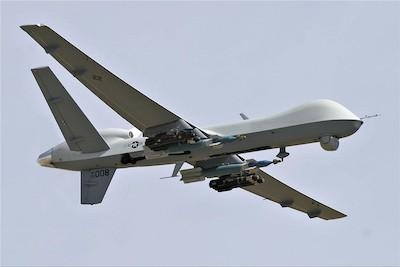Thu, Feb 27, 2020
First Such Demonstration From A MALE RPA
General Atomics Aeronautical Systems, Inc. (GA-ASI) has successfully ground tested its Airborne Laser Communication System (ALCoS) by establishing a link with a satellite in Geo-synchronous Earth Orbit (GEO). GA-ASI conducted the test with Tesat-Spacecom (TESAT), the leader of space-based laser communication (lasercom), using their GEO Laser Communication Terminal (LCT), the LCT 135. This was the first demonstration of an air-to-space lasercom system with Size, Weight and Power (SWAP) that is compatible with a Medium-altitude, Long-endurance (MALE) Remotely Piloted Aircraft (RPA).

GA-ASI tested the ALCoS from an optical observatory located on Tenerife in the Canary Islands and closed link with TESAT’s LCT 135 terminal onboard the GEO satellite Alphasat. The test successfully demonstrated acquisition and tracking, and sufficient power to close the link with the LCT 135. GA-ASI is completing the development of the flight system for use on a GA-ASI-produced MQ-9 RPA.
“This test was a critical step towards enabling our aircraft with a high-bandwidth communication system that cannot be jammed or detected by an adversary,” said Linden Blue, CEO, GA-ASI. “ALCoS allows a new generation of high-performance sensors by breaking the data bottleneck of current RF SATCOM technology.”
ALCoS is the result of a five-year, GA-ASI-funded effort to deliver Low Probability of Intercept (LPI), Low Probability of Detect (LPD) communications link to the MQ-9. With 300 times the data carrying capacity of conventional RF SATCOM systems, ALCOS will be able to operate as a gateway to the Joint Aerial Network for forward-deployed forces.
The system has the capability to work in two optical wavelengths, 1064nm and 1550nm. TESAT brings more than 12 years of experience with deployed lasercom systems for space. TESAT’s LCT 135 terminals are currently in use on seven satellites in orbit. These LCTs make over 60 satellite-to-satellite links over a distance of 45,000 km (24,300 nm) per day and have logged over 30,000 links total. TESAT has proven the commercial viability of laser satellite communications.
(Image provided with General Atomics news release)
More News
Aero Linx: Model Aeronautical Association of Australia MAAA clubs are about fun flying, camaraderie and community. For over 75 years, the MAAA has been Australia’s largest fl>[...]
Touchdown Zone Lighting Two rows of transverse light bars located symmetrically about the runway centerline normally at 100 foot intervals. The basic system extends 3,000 feet alon>[...]
“Discovery and innovation are central to our mission at Virgin Galactic. We’re excited to build on our successful record of facilitating scientific experiments in subor>[...]
How To Get A Story On Aero-TV News/Feature Programming How do I submit a story idea or lead to Aero-TV? If you would like to submit a story idea or lead, please contact Jim Campbel>[...]
Student Pilot Reported That During Rotation, “All Of A Sudden The Back Of The Plane Kicked To The Right..." Analysis: The student pilot reported that during rotation, “>[...]
 ANN's Daily Aero-Linx (05.02.24)
ANN's Daily Aero-Linx (05.02.24) ANN's Daily Aero-Term (05.02.24): Touchdown Zone Lighting
ANN's Daily Aero-Term (05.02.24): Touchdown Zone Lighting Aero-News: Quote of the Day (05.02.24)
Aero-News: Quote of the Day (05.02.24) ANN FAQ: Contributing To Aero-TV
ANN FAQ: Contributing To Aero-TV NTSB Final Report: Cirrus Design Corp SR20
NTSB Final Report: Cirrus Design Corp SR20



